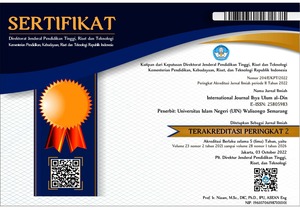Pemikiran Abdullah Ahmed An-Naim tentang Dekontruksi Syari’ah sebagai Sebuah Solusi
DOI:
https://doi.org/10.21580/ihya.20.2.4044Keywords:
Law, Dekontruksi Syari'ah, Teory of Evolution, ConceptsAbstract
The laws contained in the Qur'an still exist that require interpretation and have the potential to develop. Muslims worldwide may be entitled to apply Islamic law, provided it does not violate the rights of other people and groups, both within and outside of the Islamic community. That is, in claiming and using individual and collective rights to self-determination, Muslims must also recognize and guarantee equal rights for others. Abdullah, descriptive-analytical nature. Ahmed An-Naim to answer the gap between shari'ah and issues of modernity . Shari'a decontructions are used for Islamic legal issues using the Knife of Analysis used first by Mahmud Thaha's Theory of Law Evolution, the second nasikh mansukh theory, the third Makiyyah and Madaniyah, the fourth the interpretation of the gender-based text, the fifth concept of shari'a on human rightsDownloads
References
Abd. Salam Arief. 2003. Pembaruan Pemikiran Hukum Islam. Yogyakarta: LESFI.
Abdullahi Ahmed An-Na’im. 2004. Dekonstruksi Syari’ah (Jilid 1); Wacana Kebebasan Sipil, HAM Dan Hubungan Internasional Dalam Islam. Yogyakarta: LKiS.
———. 2009. Dekonstruksi Syari’ah (Jilid 2) ; Kritik Konsep, Penjelajahan Lain. Yogyakarta: LKiS.
Al-Qattan. 1976. Manna’ Khalīl, At-Tasyri’ Wa Al-Fiqh Al-Islam. Makkah: Maktabah Wahbah.
Ann Elizabeth Mayer. 1996. Ambiguitas An-Naim Dan Hukum Pidana Islam”, Dalam Dekonstruksi Syari’ah (II). ed. Farid Wajidi. Yohyakarta: LKiS.
Asghar Ali al Enginer. 1994. The Right of Human in Islam, Alih Bahasa Bentang. Yogyakarta: Bentang.
Ash-Shiddiqy, and M. Hasbi. 1978. Pengantar Ilmu Fiqh. Jakarta: Bulan Bintang.
Forum Kajian Kitab Kuning. 2001. Wajah Baru Relasi Suami-Istri. Yogyakarta: LKiS.
Husnul Khatimah. 2007. Penerapan Syari’ah Islam: Bercermin Pada Sistem Aplikasi Syari’ah Zaman Nabi. Yogyakarta: Pustaka Pelajar.
Ibn Manzhur. 1990. Lisan Al-Arab. Beirut: Dar al-Fikr.
Imam Syaukani. 1997. “Abdullahi Ahmad An-Na’im Dan Reformasi Syari’ah Islam Demokratik.” Ulumuddin 2.
Inyiak Ridwan Muzir. 2006. Pengantar Penerjemah: Dekonstruksi: Sebuah Perkenalan Singkat “Membongkar Teori Dekonstruksi Jacques Derrida.” Yogyakarta: Ar-Ruzz Media.
Juhaya S. Praja. 2000. Dinamika Pemikiran Hukum Islam, Dalam Jaih Mubarok, Sejarah Dan Perkembangan Hukum Islam. Bandung: Remaja Rosda Karya.
Lahmuddin Nasution. 2001. Pembaruan Hukum Islam. Bandung: Rosdakarya.
M. Amin Abdullah. 1996. Studi Agama Normativitas Atau Historisitas. Yogyakarta: Pustaka Pelajar.
Madkur, Muhammad Sallam. 1955. Al-Fiqh Al-Islami. Makkah: Maktabah Abdullah Wahbah.
Mahmoud Mohamed Taha. 1987. The Second Message of Islam. New York: Syracuse University Press.
Mas’udi, and F. Masdar. 1995. “Meletakkan Kembali Maslahat Sebagai Acuan Syari’ah.” Jurnal Ilmu dan Kebudayaan, Ulumul Qur`an VI(3).
Musa Muhammad Kamil. 1989. Al-Madkhal Ila Al-Tasyrī’ Al-Islami. Beirut: Mua’asasah al-Risalah.
Nurdin, and Muslim K.H. 1995. Moral Dan Kognisi Islam (Buku Teks Agama Islam Untuk Perguruan Tinggi Umum). Bandung: CV. ALFABETA.
Tholkhatul Khoir. 2014. “Determinasi Eksistensial Pemikiran Hukum Islam Abdullahi Ahmed An-Naim.” ISLAMICA: Jurnal Studi Keislaman 9(1).
Yudian Wahyudi. 2010. Ushul Fikih Versus Hermeneutika; Membaca Islam Dari Kanada Dan Amerika. Yogyakarta: Nawasea Press.
Downloads
Published
How to Cite
Issue
Section
License
By submitting an article to the journal, the author(s) agree to transfer the published article's copyright to the journal, which will act as the publisher. This means the journal will have the right to publish the article in various forms, including reprints. The journal will maintain the publishing rights to the published articles.
This work is licensed under Creative Commons Attribution-ShareAlike 4.0 International License.
In line with the license, authors and third parties (readers, researchers, and others) are allowed to share and adapt the material. In addition, the material must be given appropriate credit, provided with a link to the license, and indicated if changes were made. If authors remix, transform or build upon the material, authors must distribute their contributions under the same license as the original.



